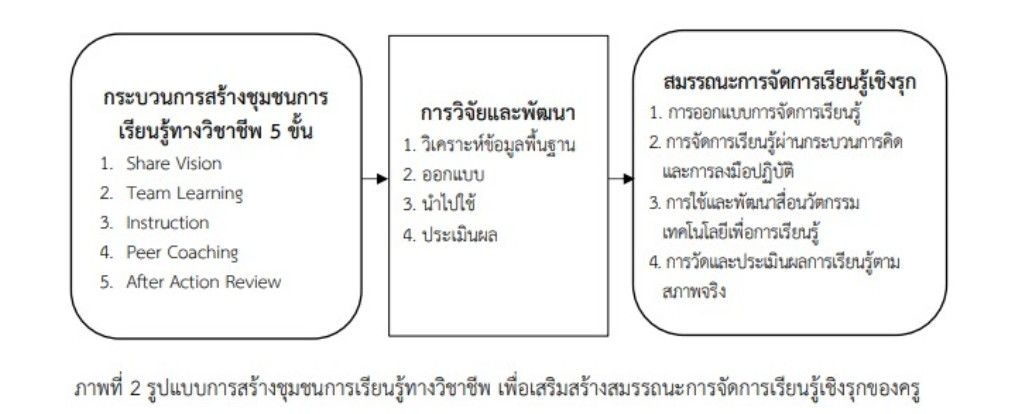การพัฒนารูปแบบการสร้างชุมชนการเรียนรู้ทางวิชาชีพเพื่อเสริมสร้างสมรรถนะการจัดการเรียนรู้เชิงรุกของครูโรงเรียนหนองสังข์วิทยายน
Main Article Content
บทคัดย่อ
การวิจัยครั้งนี้มีวัตถุประสงค์เพื่อ (1) ศึกษาข้อมูลพื้นฐานและความต้องการจำเป็นในการสร้างชุมชนการเรียนรู้ทางวิชาชีพเพื่อเสริมสร้างสมรรถนะการจัดการเรียนรู้เชิงรุกของครูโรงเรียนหนองสังข์วิทยายน สังกัดองค์การบริหารส่วนจังหวัดชัยภูมิ (2) อออกแบบและพัฒนารูปแบบการสร้างชุมชนการเรียนรู้ทางวิชาชีพเพื่อเสริมสร้างสมรรถนะการจัดการเรียนรู้เชิงรุกของครูโรงเรียนหนองสังข์วิทยายน สังกัดองค์การบริหารส่วนจังหวัดชัยภูมิ (3) ทดลองใช้รูปแบบการสร้างชุมชนการเรียนรู้ทางวิชาชีพเพื่อเสริมสร้างสมรรถนะการจัดการเรียนรู้เชิงรุกของครูโรงเรียนหนองสังข์วิทยายน สังกัดองค์การบริหารส่วนจังหวัดชัยภูมิ และ(4) ประเมินและปรับปรุงรูปแบบการสร้างชุมชนการเรียนรู้ทางวิชาชีพเพื่อเสริมสร้างสมรรถนะการจัดการเรียนรู้เชิงรุกของครูโรงเรียนหนองสังข์วิทยายน สังกัดองค์การบริหารส่วนจังหวัดชัยภูมิ โดยใช้การวิจัยรูปแบบการวิจัยและพัฒนา โดยดำเนินการเป็น 4 ขั้นตอน คือ ขั้นวิจัย (R1) ขั้นการพัฒนา (D1) ขั้นการวิจัย (R2) และขั้นการพัฒนา (D2) เก็บรวบรวมข้อมูลเชิงคุณภาพด้วยการวิเคราะห์ สังเคราะห์เอกสาร และโดยการวิเคราะห์เนื้อหาแล้วนำเสนอในรูปแบบพรรณนาความ เก็บรวบข้อมูลเชิงปริมาณด้วยแบบสอบถาม วิเคราะห์ข้อมูลโดยการวิเคราะห์เนื้อหา ความถี่ ร้อยละ ค่าเฉลี่ย และส่วนเบี่ยงเบนมาตรฐาน ผลการวิจัยสรุปได้ พบว่า (1) การวิเคราะห์ข้อมูลพื้นฐานและศึกษาความต้องการ เพื่อใช้เป็นพื้นฐานในการพัฒนา รูปแบบการสร้างชุมชนการเรียนรู้ทางวิชาชีพเพื่อเสริมสร้างสมรรถนะการจัดการเรียนรู้เชิงรุกของครูโรงเรียนหนองสังข์วิทยายน สังกัดองค์การบริหารส่วนจังหวัดชัยภูมิ โดยประเมินความเหมาะสมขององค์ประกอบโดยผู้เชี่ยวชาญ จำนวน 5 คน (2) ร่างรูปแบบการสร้างชุมชนการเรียนรู้ทางวิชาชีพเพื่อเสริมสร้างสมรรถนะการจัดการเรียนรู้เชิงรุกของครูโรงเรียนหนองสังข์วิทยายน สังกัดองค์การบริหารส่วนจังหวัดชัยภูมิ โดยตรวจสอบความสมเหตุสมผลเชิงทฤษฎี ความเป็นไปได้ และความสอดคล้องของ ร่างรูปแบบกการสร้างชุมชนการเรียนรู้ทางวิชาชีพเพื่อเสริมสร้างสมรรถนะการจัดการเรียนรู้เชิงรุกของครู ประกอบด้วย 5 ขั้นตอน ประกอบด้วย การสร้างวิสัยทัศน์ร่วมกัน (Share Vision) การเรียนรู้ร่วมกันเป็นทีม (Collaborative Learning) การจัดการเรียนรู้ (instruction) การชี้แนะแบบเพื่อนช่วยเพื่อน (Peer Coaching) และการสะท้อนคิด (Reflect) (3) การนำรูปแบบการสร้างชุมชนการเรียนรู้ทางวิชาชีพเพื่อเสริมสร้างสมรรถนะการจัดการเรียนรู้เชิงรุกของครูโรงเรียนหนองสังข์วิทยายน สังกัดองค์การบริหารส่วนจังหวัดชัยภูมิ ที่พัฒนาขึ้นไปทดลองใช้ในภาคสนาม โดยการวิจัยเชิงทดลองแบบการทดลองแบบกลุ่มตัวอย่างเดียว โดยเก็บข้อมูลจากกลุ่มตัวอย่างจากกลุ่ม จากครูผู้สอน จำนวน 24 คน และ(4) ผลการพัฒนารูปแบบการสร้างชุมชนการเรียนรู้ทางวิชาชีพ เพื่อเสริมสร้างสมรรถนะการจัดการเรียนรู้เชิงรุกของครูโรงเรียนหนองสังข์วิทยายน สังกัดองค์การบริหารส่วนจังหวัดชัยภูมิ พบว่า รูปแบบมีความเหมาะสม และมีความเป็นไปได้ ในภาพรวมอยู่ในระดับมากที่สุด
Article Details
เอกสารอ้างอิง
พิมพันธ์ เดชะคุปต์ และคณะ. (2561).วารสอนคิดด้วยโครงงาน : การเรียนการสอนแบบบูรณาการ. กรุงเทพฯ : โรงพิมพ์แห่งจุฬาลงกรณ์มหาวิทยาลัย.
เพ็ญนภา สีหาโคตร. (2564). การพัฒนารูปแบบการบริหารงานภาครัฐแนวใหม่ (NPM) เพื่อส่งเสริมสมรรถนะความเป็นครูมืออาชีพมุ่งพัฒนาสู่ผู้เรียน โรงเรียนเทศบาล 5 (กระดาษไทยอนุเคราะห์). วารสารการเรียนรู้และการศึกษา, 1(1), 17-28.
มาเรียม นิลพันธุ์. (2553). วิธีวิจัยทางการศึกษา. (พิมพ์ครั้งที่ 4). นครปฐม: โรงพิมพ์มหาวิทยาลัยศิลปากร.
โรงเรียนหนองสังข์วิทยายน. (2563). ข้อมูล SAR โรงเรียนหนองสังข์วิทยายน. ชัยภูมิ: เอกสารอัดสำเนา.
วัชรา เล่าเรียนดี. (2556). ศาสตร์การนิเทศการสอนและการโค้ชการพัฒนาวิชาชีพ: ทฤษฎีกลยุทธ์สู่การปฏิบัติ. (พิมพ์ครั้งที่ 12). นครปฐม: โรงพิมพ์มหาวิทยาลัยศิลปากร วิทยาเขตพระราชวังสนามจันทร์.
วิจารณ์ พานิช. (2555). วิถีสร้างการเรียนรู้เพื่อศิษย์ในศตวรรษที่ 21. กรุงเทพฯ: มูลนิธิสดศรี-สฤษดิ์วงศ์.
สถาบันที่ปรึกษาเพื่อพัฒนาประสิทธิภาพในราชการ (สปร.). (2557). คู่มือการกำหนดสมรรถนะของข้าราชการส่วนท้องถิ่น: คู่มือสมรรถนะประจำตำแหน่ง. https://www.lankrabue.go.th/dnm_file/project/31095506_center.pdf
สํานักงานคณะกรรมการการศึกษาขั้นพื้นฐาน. (2553). คู่มือการประเมินสมรรถนะครู. กรุงเทพมหานคร: สํานักงานคณะกรรมการการศึกษาเอกชน.
สํานักงานคณะกรรมการการศึกษาขั้นพื้นฐาน. (2560). คู่มือประกอบการอบรมการขับเคลื่อนกระบวนการPLC (Professional Learning Community) “ชุมชนการเรียนรู้ทางวิชาชีพ” สู่สถานศึกษา. http://skn-peo.go.th/home/datas/file/1557980186.pdf
สำนักงานเลขาธิการสภาการศึกษา. (2562). บทเรียนจากสถานศึกษาในการพัฒนาครูดวยชุมชนแหงการเรียนรูเชิงวิชาชีพ (PLC) สูการพัฒนาผูเรียนตามมาตรฐานการศึกษาของชาติ. นนทบุรี: บริษัท 21 เซ็นจูรี่ จํากัด.
สุภาวดี ปกครอง. (2561). การพัฒนาระบบพัฒนาครูโดยใช้แนวคิดชุมชนการเรียนรู้ทางวิชาชีพ ในการจัดการเรียนรู้เพื่อการอ่านออกเขียนได้ของนักเรียนโรงเรียนประถมศึกษา. วิทยานิพนธ์ปริญญาการศึกษาดุษฎีบัณฑิต สาขาวิชาการบริหารและพัฒนาการศึกษา มหาวิทยาลัยมหาสารคาม.
Dufour, R. (2007). Professional learning community: A bandwagon, an idea worth considering, or our best hope for high levels of learning. Middle School Journal, 39(1), 4-8.
Hipp, K.K., and Weber, P. (2008). Developing a Professional Learning Community Among
Urban School Principals. Journal of Urban Learning, Teaching and Research, 4(2),
-56.
Hord, S. M., & Summers, W. A. (2008). Leading Professional Learning Communities: Voices from Research and Practice. Thousand Oaks, CA: Corwin.
Stoll, L., & Louis, K.S. (Eds.). (2007). Professional learning communities: Divergence, depth, and dilemmas. New York: McGraw Hill.
Padwad, A. and Dixit, K.K. (2008). Impact of Professional Learning Community Participation on Teachers' Thinking about Classroom Problems. TESL-EJ, 12(3), 1-11.
Sackney, L., Walker, K., Mitchell, C. (2005). Building capacity for learning communities: schools that work REICE. Revista Electrónica Iberoamericana sobre Calidad, Eficacia y Cambio en Educación, 3(1), 9-16.


